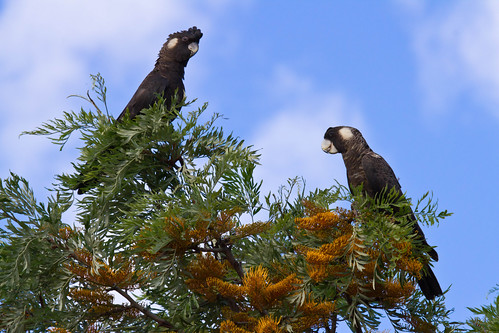 Black cockatoos are in danger of becoming wiped out. Image by Michaela NewmanFEARS for three species of endangered black cockatoos have arisen over plans to log an area of Helms forest block near Nannup.
Black cockatoos are in danger of becoming wiped out. Image by Michaela NewmanFEARS for three species of endangered black cockatoos have arisen over plans to log an area of Helms forest block near Nannup.
The area is one which was not burned during the recent fires and therefore one of the remaining sources of food for the iconic species.
Concerns were raised last week by the Conservation Council, which held a crisis meeting in Perth to discuss solutions for the impending starvation crisis affecting the three species.
The council said large numbers of Carnaby’s, Baudin’s and forest red-tailed black cockatoos were starving to death due to a lack of feeding habitat.
“The recent very large bushfires in the South West combined with the impacts of last year’s drought has created a food crisis for cockatoos,” Conservation Council of WA director Piers Verstegen said.
Greens MLA Giz Watson, who will contest a South West Legislative Council seat next year, joined calls for an immediate moratorium on clearing of the threatened black cockatoos' food sources.
"The black cockatoo populations are under threat of local extinctions due to a number of factors," Ms Watson said.
"Recent massive fires have hugely impacted the food sources and imminent logging will destroy more.
“Further loss of habitat must be stopped while the huge areas of burnt bush recover."
However, the Forest Products Commission (FPC) said there was abundant habitat for roosting and feeding in reserved forest near Helms and in adjacent state forest that was not scheduled for harvesting.
Specially selected and marked habitat trees will be distributed through the harvested area at an average of at least 12 trees per hectare.
FPC spokesman Peter Beatty said the Helms forest block covered 4,280ha.
“The net harvestable area in the Helms 02 harvest coupe is 490 hectares,” he said.
“Immediately west of Helms forest block is a large National Park.
“Within and adjacent to the coupe there is at least 300 hectares of other forest that is protected from harvesting in informal reserves.”
Mr Beatty said the forest area burnt in the recent bushfire was nearly 20 kilometres to the south.
“Helms block is approximately 14 kilometres to an area that was control burned in 2011.
“Most of Helms block was last control burned in 2007,” he said.
Mr Beatty said recent fire history within and in close proximity to the harvest coupe was considered when planning and scheduling harvest operations.
“Habitat recovery may be an important factor in such cases,” he said.
“The most recent wildfire well to the south of Helms 02 is not considered a relevant factor in the timing or method of harvesting in this particular coupe.
“An area of 260 hectares was harvested in the northeast of Helms in early 2007.
“It is now showing prolific regrowth recovery and contains a healthy spread of over storey and mature trees.
“Issues associated with cockatoo habitat were raised prior to harvesting and FPC implemented all required protection practices, while also liaising directly with local cockatoo carers.”
The Department of Environment and Conservation (DEC) confirmed the decline of the black cockatoo population despite various DEC initiatives to increase their numbers.
They estimated the local wild populations of Carnaby’s at 40,000, Baudin’s approaching 15,000 and forest red-tail cockatoos at 10,000.